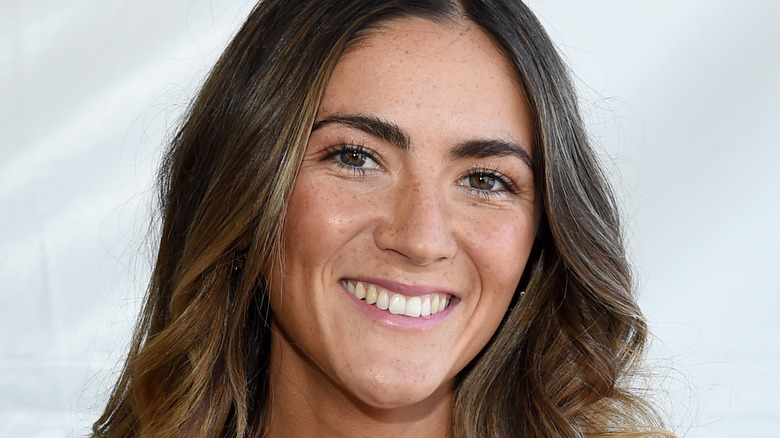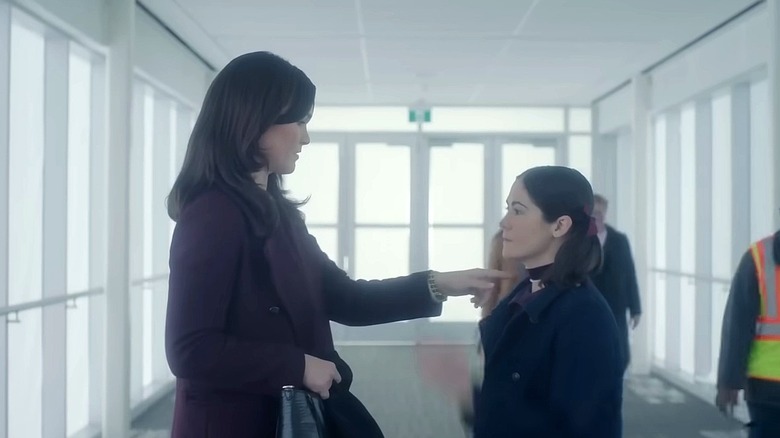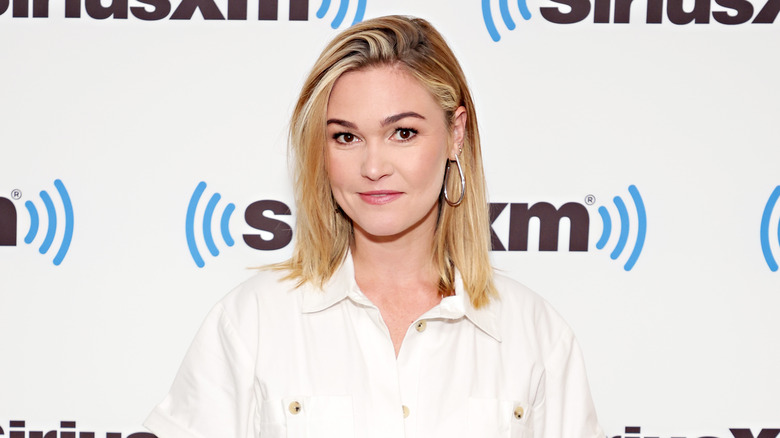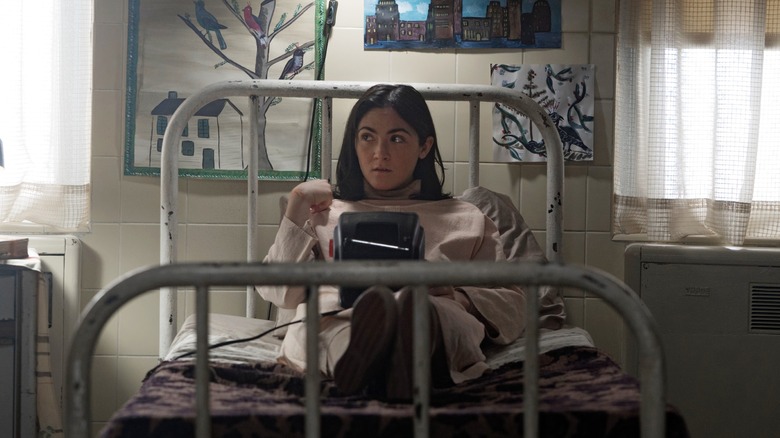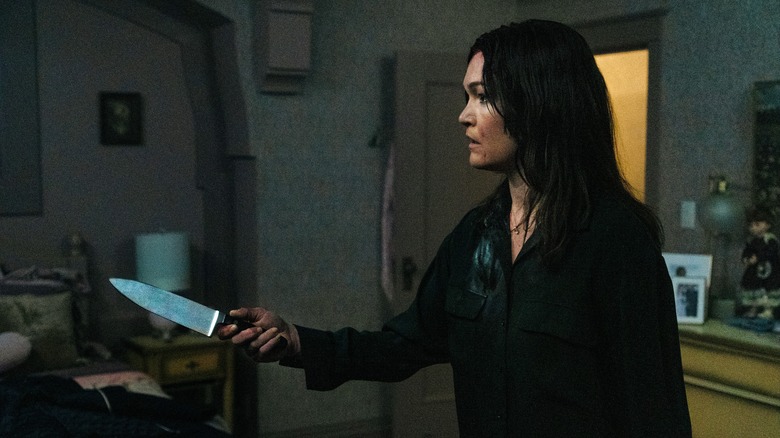Orphan: First Kill's Isabelle Fuhrman And Julia Stiles On How The Unique Villain Was Brought Back - Exclusive Interview
Following the terrifying conclusion of the horror thriller "Orphan" in 2009, neither star Isabelle Fuhrman nor her future co-star, Julia Stiles, ever could have imagined another tale about the villainous character of Esther being made. Chief among the reasons was that Fuhrman, who was 12 at the time "Orphan" was released, clearly outgrew the possibility of replicating the look of a 9-year-old girl. That all changed, though, when "The Boy" director William Brent Bell found a creative way for Fuhrman to reprise the role, and the film's writing team crafted a wickedly clever origin story that opened the door for Stiles to join the new "Orphan" prequel film "Orphan: First Kill."
Fuhrman made big waves for her villainous turn in "Orphan," a twisty psychological horror tale about Esther, a 9-year-old Russian orphan who is adopted by a grieving couple, Kate and John (Vera Farmiga and Peter Sarsgaard), following the tragic stillbirth of their third child. Immediately realizing there is something off about Esther, Kate — whose suspicions are further raised by the way the girl is acting around her other two children and is witnessing coincidences too hard to ignore — digs into the orphan's past and discovers she is actually a 33-year-old Estonian woman named Leena Klammer. Afflicted with a rare hormonal disorder that stunts growth and causes proportional dwarfism, Leena, who has disturbing homicidal tendencies, poses as Esther, a seemingly sweet and innocent child who has much more sinister intentions in mind once she is adopted by Kate and John.
Inspired by a true story, "Orphan: First Kill" fills in much of Esther-Leena's backstory first examined in "Orphan," which begins with Leena's escape from an Estonian asylum and her posing as the daughter of wealthy couple Tricia and Allen (Stiles and Rossif Sutherland), seemingly resurfacing in their lives after she went missing years before. Fuhrman and Stiles sat down with Looper to discuss the film in an exclusive interview.
Practical effects helped turn Fuhrman into a 9-year-old
Isabelle, I mentioned to you how spooked I was by "Orphan" when we talked during press tour for "The Hunger Games" 10 years ago, and I don't think either one of us could have imagined talking about an "Orphan" prequel 10 years later. But now it seems like it was a matter of technology catching up to make it happen.
Isabelle Fuhrman: I don't know if it was necessarily about technology because we actually didn't use any CGI or visual effects in this movie. A lot of it — most of it — was actually practical. We did a lot of forced perspective and camera work to make me look like I was a kid.
It was more so that the movie came out, [and] it did really well in the U.S., but even better around the world. I don't know if anybody thought about making a prequel until realizing how much of a cult classic the movie became. It was only in 2019 that we got the ball rolling and got this made.
There was no technology involved, no de-aging or anything like that? That's remarkable!
Fuhrman: No. I wore contact lenses in my eyes, and other than that, Julia wore super tall boots, and I squatted a lot when we were filming scenes. There was a little butt dolly thing that I would use to walk on this little chair. I had two body doubles that were me from all the different angles, Kennedy [Irwin] and Sadie [Lee], who are wonderful actresses that helped us bring Esther back.
Stiles also had to get creative to act opposite Fuhrman
Julia wore stilts for the role? I love the commitment! Julia, I'm sure that you were familiar with "Orphan" coming into this picture, and seeing Isabelle bring this character to life again must have blown you away.
Julia Stiles: It blew my mind. It really did. I would sit there on set watching her work and go, "Oh, my God." It's not just about making her look shorter or tricks of the camera to make her look tinier. It was that her voice and her mannerisms felt like she was a child, and the movie hinges on that because she has to trick everybody around her, but it worked really well.
I was the one who wore lifts. I wish I had worn stilts! That would've been less humiliating than wearing these leather thigh-high boots with platforms that kept getting bigger. We call them "the Gene Simmons boots."
The years between Orphan and Orphan: First Kill gave Fuhrman a different perspective of the role
Isabelle, was it tougher approaching the role back when you did "Orphan" from a child's vantage point or in this film 10 years later, where you play Esther or from an adult's vantage point? Since you were a young girl when making the first film, I'm wondering if you're looking at the role a bit differently now that you've grown up.
Fuhrman: My vantage point as a child when I was approaching the movie was really different than now. I had a whole team of people that helped create Esther for me and with me. As a kid, it was about doing the best I could to bring this vision to life that was in the script. It was the first movie I ever did, and working on your first film ... It's not necessarily that you can't say certain things, but it's more that you don't know.
You're treading softly and you've never been on a set before, and you don't know how much freedom you have in your character and what you can play with. Also, everyone had a very specific idea of who Esther was the first time around, so a lot of the work that I did on the character was with the dialect. "What is she feeling in this moment?" It was coming from a place of trying to understand Esther's emotional place.
This time around, I actually wanted to try and capture that again, because it's very easy to over-intellectualize something. As you get older, you understand all the intricacies of the conversations of what's being said, of what she's actually trying to do and the manipulation. Being able to find a way to marry the two — what I've learned since I've grown as a woman, as an actress, to where I was when I was a kid and to all the ideas and wisdom that I had from the original script — all came together with this cocktail to help bring Esther back for me.
I wouldn't say that one was better than the other when I was a kid or now. They were both completely different experiences. I had definitely more freedom this time around to play.
Stiles was thrilled that her role in Orphan: First Kill defied horror film conventions
Julia, the great thing about "Orphan: First Kill" is that the movie is not only about Esther, but also about your character, Tricia. I'm sure you didn't see the wickedly smart turns coming when you read the script, and without spilling any details, you had to have been thrilled to find out the brilliant stuff created for your character.
Stiles: Yes, thank you. Those are all the reasons that I was drawn to be a part of the movie. A lot of times in a horror film or a scary film, [for some characters], the story doesn't really do them justice. This film is way more sophisticated and more fun than your average horror movie.
A lot of times, unless you're playing the villain or unless you're playing the main character, the other roles can usually be like you're playing a character that's in distress all the time. I was so excited when I read the script for "Orphan: First Kill" where there's this major twist that is very surprising.
I didn't see it coming, but it's also delicious — because Tricia, the character that I play, is in some ways like Esther, and she has met her match. We're in on the secret, so we're looking at Esther like, "How much longer is she going to get away with this [charade of playing a kid]?" and we're waiting for Tricia to figure it out. But it's a really fun part, and there's definitely more to her than meets the eye.
Also starring Matthew Finlan in a pivotal role as the Albright's teenage son, Gunnar, "Orphan: First Kill" opens in select theaters and debuts Friday, August 19, on Paramount+.
This interview was edited for clarity.
